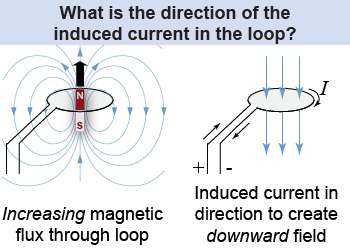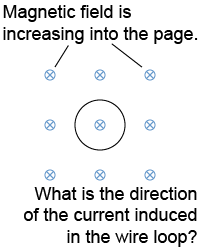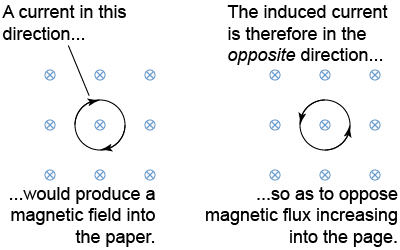|
Does a magnet inside a solenoid cause electricity to flow in the solenoid’s wire? It depends! When the magnet is moving into the solenoid, an ammeter connected to the circuit shows electric current called an induced current. When the magnet stops moving, the current stops, too. When the magnet is moved backward out again, current starts up again—but flows in the opposite direction! The magnet induces a current in the wire, but only when the magnet is moving relative to the wire. The phenomenon of a moving magnetic field inducing an electric current is called electromagnetic induction. 
|

|
What was happening when the magnet moved in and out of the solenoid? The movement of the magnetic field caused a change in the magnetic flux through every loop of wire in the solenoid. Changing magnetic flux induces electric current in a conductor. Since electric current will flow only when there is an electric field inside the conducting wire, we could also say that changing magnetic flux induces an electric field in the wire. 
|
In magnetic induction, work is being done to move the electric charges around the coil—i.e., to create the electric current. The work done per unit charge is called the electromotive force (emf), although it is not really a force. The units of emf are joules per coulomb or volts. In magnetic induction, a changing magnetic flux creates an induced emf. 
|
In 1831, Michael Faraday conducted a series of experiments similar to the illustration above to discover electromagnetic induction. Faraday’s law of induction (equation 19.2) states that the induced emf in a circuit is proportional to both the rate of change of the magnetic flux and the number of coils in the wire. 
 |
In America, Joseph Henry independently conducted similar experiments around the same time as Faraday, but Henry did not publish his results. The Italian scientist Francesco Zantedeschi may also have published results showing induction two years earlier than Faraday. Nonetheless, Faraday published his results and they became widely known, so Faraday is usually credited with the discovery of electromagnetic induction. 
|
| (19.2) | | | emf | = | induced emf (V or J/C) | | N | = | number of turns of coil | | ΔΦB | = | change in magnetic flux (T m2) | | Δt | = | change in time (s) |
| Faraday’s law
|
|
 When a current is induced, in what direction will it flow? Lenz’s law states that the direction of the induced current is such that the current’s magnetic field acts to oppose the original change in magnetic field. Lenz’s law describes how the induced current acts to resist changes in magnetic flux—similar to how the inertia of an object causes it to resist changes in its velocity. Lenz’s law therefore provides the minus sign in equation (19.2)!
When a current is induced, in what direction will it flow? Lenz’s law states that the direction of the induced current is such that the current’s magnetic field acts to oppose the original change in magnetic field. Lenz’s law describes how the induced current acts to resist changes in magnetic flux—similar to how the inertia of an object causes it to resist changes in its velocity. Lenz’s law therefore provides the minus sign in equation (19.2)! 
 |
If Lenz’s law had the opposite sign, then the changing magnetic flux would cause an induced current that would, in turn, create a larger changing magnetic flux, which would cause an even larger induced current, and so on. It would be a positive feedback loop that would create a runaway reaction in violation of energy conservation! 
|
 A wire loop is located in the plane of the page. If a magnetic field across the page is increasing in the direction into the page, what is the direction of the current induced in the wire loop? (Recall that the notation for a circle with an “X” inside it means that the magnetic field vector is pointing into the page.)
A wire loop is located in the plane of the page. If a magnetic field across the page is increasing in the direction into the page, what is the direction of the current induced in the wire loop? (Recall that the notation for a circle with an “X” inside it means that the magnetic field vector is pointing into the page.)
 |
 Use the right-hand rule to determine the direction of current in the wire loop that would create a magnetic field in the direction of the increasing magnetic field (or magnetic flux). The direction of the induced current is therefore in the opposite direction—i.e., the direction that opposes this increasing magnetic field.
Use the right-hand rule to determine the direction of current in the wire loop that would create a magnetic field in the direction of the increasing magnetic field (or magnetic flux). The direction of the induced current is therefore in the opposite direction—i.e., the direction that opposes this increasing magnetic field. 
|

